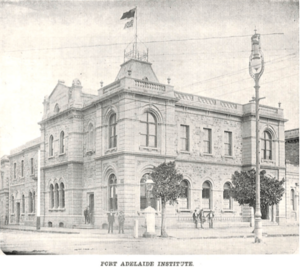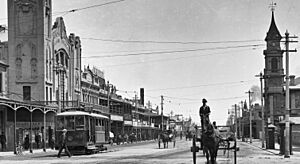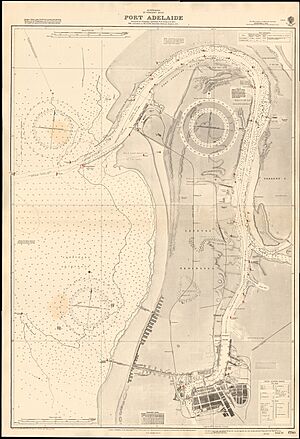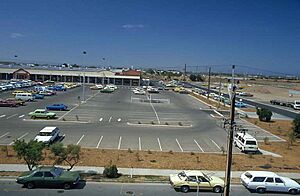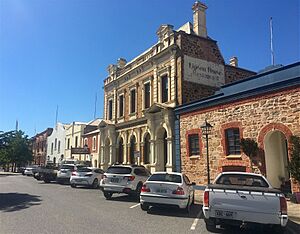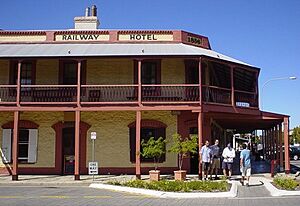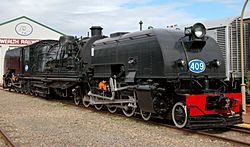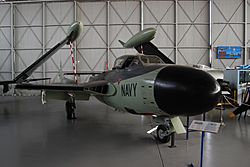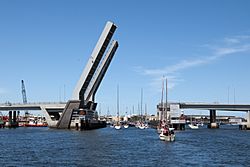Port Adelaide facts for kids
Quick facts for kids Port AdelaideAdelaide, South Australia |
|||||||||||||||
|---|---|---|---|---|---|---|---|---|---|---|---|---|---|---|---|
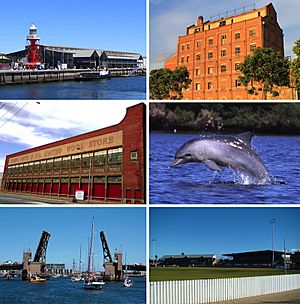
Clockwise, from top: Port Adelaide Lighthouse and Fishermen's Wharf Market, Hart's Mill, Port River Dolphin, Alberton Oval, Birkenhead Bridge, Wool Stores
|
|||||||||||||||
| Established | 1836 | ||||||||||||||
| Postcode(s) | 5015 | ||||||||||||||
| Location | 14 km (9 mi) from Adelaide CBD | ||||||||||||||
| LGA(s) | City of Port Adelaide Enfield | ||||||||||||||
| State electorate(s) | Port Adelaide | ||||||||||||||
| Federal Division(s) | Hindmarsh | ||||||||||||||
|
|||||||||||||||
| Footnotes | Adjoining suburbs | ||||||||||||||
Port Adelaide is a lively port area in Adelaide, Australia. It's about 14 kilometers (9 miles) northwest of the city center. This area is super important because it's Adelaide's main port.
Port Adelaide also gives its name to the local council, a suburb, and even some voting areas. It played a huge role in the early days of Adelaide and South Australia. It was the main way for the young colony to get supplies and news from the rest of the world. The local Kaurna people call this area Yertabulti.
Contents
Exploring Port Adelaide's Past
Port Adelaide used to be covered in mangrove swamps and muddy areas. The Kaurna people lived here, calling the whole river area 'Yartapuulti'. Europeans first saw the Port River in 1831. Captain Henry Jones explored it in 1834. The river was deep enough for small boats, but it was narrow and surrounded by swamps.
Choosing Adelaide's Port
In late 1836, Colonel William Light looked for a good spot for South Australia's port. He thought this location, then called "the port creek," was suitable. Some people disagreed because it was far from Adelaide. But Light decided to keep the port and city separate. This was mainly because the port area didn't have enough fresh water.
Early Days of the Port

Port Adelaide officially started on January 6, 1837. Captain Thomas Lipson, the first harbourmaster, moved there with his family. Ships started using the new port later that month. Passengers also began arriving. At first, the area was known as The Port Creek Settlement.
The port was often flooded at high tide. There was also a big problem with not enough fresh water. Large ships couldn't get close to the settlement. They had to stop far away, and people used smaller boats to reach land. The area was full of mosquitoes and far from Adelaide. By 1840, people even called it "Port Misery."
Colonel Light had imagined building a canal between Port Adelaide and Adelaide city. But this was too expensive at the time. A plan for a "Grand Junction Canal" was made in 1851, but it was never built.
Building the Wharves
The first wharf was meant to be temporary. Governor George Gawler chose a better spot for a permanent port. He allowed the South Australian Company to build a private wharf to save government money. This wharf, called McLaren Wharf, was finished in 1840. It was named after David McLaren, the company manager.
McLaren Wharf was 102 meters (336 feet) long and 4.6 meters (15 feet) deep at low tide. Governor Gawler opened it in October 1840. Over 1,000 people attended the opening, which was the biggest gathering of colonists yet. The port could handle ships up to 530 tons.
Over time, the land was raised by about 2.7 meters (9 feet) using mud from dredging. This helped prevent flooding. By the mid-1840s, more private wharves were built because trade was growing.
Port Adelaide's Golden Age (1860-1970)
In 1874, the Port Adelaide Institute started building its new home. It opened two years later, offering a library, reading room, museum, and classrooms. Gas street lights were put up in 1881. The town got its first electric lights in 1889.
By 1876, about 5,000 people lived in Port Adelaide. By 1911, it was the second-largest city in South Australia. Many different communities lived here, including Jewish and Scandinavian people. The Port Adelaide Caledonian Society, founded in 1883, is still active today.
The town grew, and its harbor facilities expanded. Many impressive old buildings from this time still stand. In 1982, a large part of the town center became a State Heritage Area. This means its historic buildings are protected.
The Outer Harbor was built in the early 1900s for bigger ships. In the 1920s and 1930s, the Port Adelaide wharves were rebuilt. This changed the look of the inner harbor.
Changes and Renewal (1970-Present)
In the 1960s, a new way of handling cargo called containerisation arrived. This meant fewer workers were needed at the port. Also, new shopping centers opened nearby, making Port Adelaide less popular for shopping. Many historic buildings became empty.
People started talking about redeveloping the waterfront in 1975. In 2002, a big project called "Newport Quays" was planned. It aimed to build 2,000 homes and create 4,000 jobs.
In 2004, Premier Mike Rann announced a special dolphin sanctuary in the Port River and Barker Inlet. This was the world's first "urban" dolphin sanctuary. The Adelaide Dolphin Sanctuary Act was passed in 2005.
By 2009, the National Trust of Australia said Port Adelaide was one of Australia's most at-risk heritage sites. Not enough people were living or visiting the area.
A New Beginning (2010-Present)
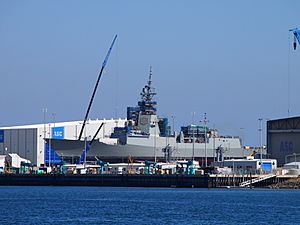
Things started to change in 2010. A large naval construction center called Techport opened at Osborne. It helps build ships for the Navy, like the $8 billion Air Warfare Destroyer. Techport has the largest ship lift in the Southern Hemisphere.
In 2015-2016, a new apartment building was built. In 2016, plans were announced to develop 23 hectares of empty waterfront land. This project, later called Fletcher's Slip, will involve over $1 billion in investment. Also in 2016, the government chose DCNS to build 12 submarines for the Royal Australian Navy in Port Adelaide.
In 2017, a new office tower was built for public servants. The historic Port Admiral Hotel, built in 1849, reopened after a big renovation. New restaurants also opened, bringing more life to the area.
In 2018, Pirate Life Breweries moved into a refurbished warehouse in Port Adelaide. The Port Canal Shopping Centre also began a big redevelopment to become Port Adelaide Plaza. New homes are being built, and the Port Adelaide Pirates Soccer Club moved to a new sports complex. In 2020, the first house in the suburb sold for $1 million.
Historic Buildings and Pubs
Port Adelaide is famous for its well-preserved 19th-century pubs and hotels. They show the area's history of serving sailors from trading ships.
Town Hall
The Port Adelaide Enfield Council Offices building was once the Port Adelaide Town Hall. Built in 1939, it is now a protected heritage site.
Famous Pubs and Hotels
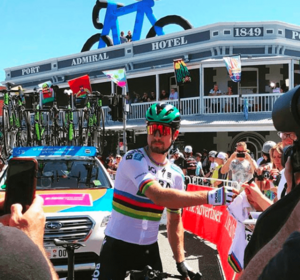
The Port Hotel opened in 1838, even before the port was officially declared. The First Commercial Inn, opened in 1841, has the longest history of being licensed, though not continuously.
The British Hotel has been continuously licensed since 1847. It was rebuilt in 1876. The Dockside Tavern, built in 1850, was rebuilt in 1898. The Golden Port Tavern used to be called The Globe.
Black Diamond Square is a main intersection in Port Adelaide. It's named after the Black Diamond Hotel, which opened in 1851 as the White Horse Cellars Inn. It had a large theater and was used for a freemason hall and library.
The Port Dock Brewery Hotel, built in 1855, was once called the Dock Hotel. It lost its license in 1909 but reopened as a hotel and small brewery in 1986. The Railway Hotel, opened in 1856, still has many original features.
| List of hotels and pubs in Port Adelaide | |
|---|---|
| Port Admiral Hotel | 1849 |
| Birkenhead Riverview Tavern | 1877 |
| The British Hotel | 1847 |
| Dockside Tavern | 1850 |
| First Commercial Inn | 1841 |
| The Lighthouse Hotel | 1857 |
| Newmarket Hotel | 1879 |
| Port Anchor Hotel | 1873 |
| Port Dock Brewery Hotel | 1855 |
| Railway Hotel | 1856 |
| Royal Arms Hotel | 1878 |
The Kent Hotel, now the Port Anchor Hotel, was once two houses. The Brunswick Pier Hotel, opened in 1878, later became a pharmacy. The Newmarket Hotel, opened in 1879, was originally a market building. The Colac Hotel, opened in 1881, has strong ties to the Labor Party and unions.
Between 1838 and 1906, sixty different hotels operated in Port Adelaide. In 1906, voters decided to reduce the number of liquor licenses by a third. This meant 15 hotels and three wine licenses were not renewed in 1909.
Geography and Nature
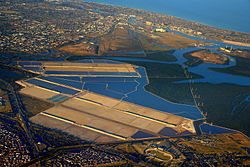
Port River
The Port River, also called the Port Adelaide River, is home to a group of bottlenose dolphins. The river's inner harbor has thick areas of Grey mangroves. These mangroves are home to hundreds of different kinds of marine animals, birds, and insects. The Port River is also important for blue swimmer crabs and western king prawns.
Port Adelaide is bordered by the Port River and Inner Harbour to the north and west. Webb Street and Grand Junction Road are to the south. The main street is St Vincent Street. There are also residential areas along Commercial Road and Webb Street. New homes have been built along the waterfront.
Port Adelaide is a tidal port, meaning the water level changes with the tides. It has several shipping berths along the river.
Parks
Port Adelaide has many parks. One of the newest is the Hart's Mill precinct, which was updated in 2014. It's a great place for events and relaxation.
Markets
Port Adelaide has several markets. These include the Torrens Island Food Market and the Fishermen's Wharf Market. The Fishermen's Wharf Market was in Shed 1, the last remaining wharf shed in the inner harbor. The markets closed in late 2022.
Culture and Community
Port Adelaide has a history as a working-class area. This is because of all the jobs created by the wharves and industries.
Social Progress
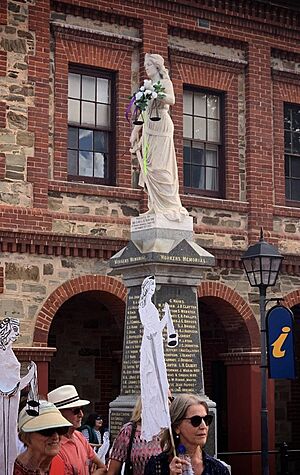
Port Adelaide has a long history of supporting social change and progressive movements. For example, unions fought for better working conditions on the wharves. More recently, the area has helped support local Indigenous communities. The Port Adelaide Football Club also works to help Indigenous people and youth. Important people in these movements are honored at the Port Adelaide Workers Memorial.
Art and Creativity
Famous painters like Mortimer Menpes and Margaret Preston were born or grew up in Port Adelaide. The area's diverse scenery has attracted many artists.
The Port Adelaide Artists Forum organizes events for local artists. You can find galleries like the Black Diamond Gallery and Gallery Yampu. The Jackalope Studio Gallery is a working studio and sells art from Mexico.
There are also public artworks, like Glow / Taltaityai, which are glow-in-the-dark sculptures of ibis and emu. They represent a Tjilbruke Kaurna Dreaming story. The Wonderwalls Festival brings international artists to create amazing street art on buildings, attracting thousands of visitors.
Music Scene
The Hart's Mill precinct hosts events like the Adelaide Guitar Festival. The biggest music festival in Port Adelaide is St Jerome's Laneway Festival. The Semaphore Music Festival also holds events at Hart's Mill.
The Waterside Workers Hall is a venue for concerts, performance art, and comedy. The Largs Pier Hotel used to host early Adelaide rock bands. Port Adelaide also has notable vinyl record stores like Porthole Records.
Movies and Television
Port Adelaide's unique mix of maritime, historic, modern, and industrial buildings makes it a popular spot for movies and TV shows. Films like Mortal Kombat (2021) have used the area as a backdrop.
Sports and Teams
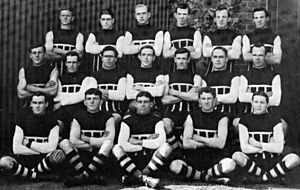
Port Adelaide has a strong sports tradition. Most local clubs use black and white colors and the magpie as their symbol.
Sporting Clubs
- Port Adelaide Athletics Club (started 1870)
- Port Adelaide Rowing Club (started 1877)
- Port Adelaide Sailing Club (started 1897)
- Port Adelaide Cricket Club (started 1897)
- Port Adelaide Cycling Club (started 1897)
- Port Adelaide Baseball Club (started 1889)
- Port Adelaide Pirates (Soccer) (started 1903)
- Port Adelaide Bowling Club (started 1903)
- Port Adelaide Rugby Union Club (started 1933)
- Port Adelaide District Hockey Club (started 1934)
- Port Adelaide Tennis Club (started 1973)
Port Adelaide Football Club
Port Adelaide is home to the famous Port Adelaide Football Club. This Australian rules football team trains and plays its South Australian National Football League (SANFL) games at Alberton Oval. The club started in 1870. It joined the Australian Football League (AFL) in 1997. It was the only non-Victorian club to join the AFL directly. Before joining the AFL, the club won 34 SANFL Premierships. Its reserve team still plays in the SANFL.
Learning and Museums
Tauondi Aboriginal College
Tauondi Aboriginal College is located at 1 Lipson Street.
National Railway Museum
A railway museum opened in 1963. In 1988, it moved to Port Adelaide and was called the Port Dock Railway Museum. It was renamed the National Railway Museum in 2001. It is located in the old Port Dock railway station.
Visitors can ride historic trains. Bub, a small steam locomotive, takes passengers around the museum. Another steam locomotive, Bill, runs along the seafront between Semaphore and Fort Glanville Conservation Park part of the year.
The museum is run by volunteers and a small staff. It has tracks and trains from all three main rail gauges used in South Australia. You can see locomotives and rail cars in two large buildings. The Port Dock Goods Shed, built in the 1870s, is the last building from the old railway station. The museum also has a shop and hosts special events.
South Australian Maritime Museum
The South Australian Maritime Museum is on Lipson Street, inside a historic warehouse. It has Australia's oldest nautical collection, started in 1872.
City of Adelaide Clipper
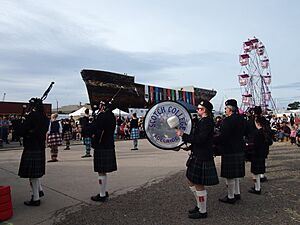
The historic 1864 clipper City of Adelaide returned to Port Adelaide in 2014 after a 14-year effort. The ship made 23 voyages to South Australia between 1864 and 1886. It brought about 889 passengers who came to settle here.
The ship's hull is currently stored on a barge in the port's inner harbor. A big celebration was held for its 150th anniversary in 2014.
South Australian Aviation Museum
The South Australian Aviation Museum is the state's official aviation museum. It is run by a non-profit group and opened at its current Lipson Street site in 2006. It's right next to the railway museum.
The museum has a collection of aircraft, including a retired Lockheed AP-3C Orion and a General Dynamics F-111C. You can also see a Spitfire Mark VC that crashed in 1943 and a de Havilland Sea Venom.
Austbuilt Maritime Museum
The Austbuilt Maritime Museum is run by the Port Adelaide Historical Society. It has a large collection of maritime items. These were collected by Keith Le Leu, who famously bought the steam tug Fearless for $1 in 1972. The museum and several anchors around Port Adelaide form the Port Adelaide Anchor Trail.
Australian Museum of Childhood
The Australian Museum of Childhood shows a collection of toys made in Australia from the 1890s onwards. Alan Griffiths collected these toys over 30 years.
Transport and Bridges
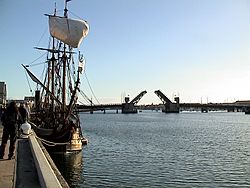
The first road in the area was built in 1840. It was about 1.6 kilometers (1 mile) long and connected the port to dry land. The cost was so high that the company building it charged a toll.
The Port River was first crossed by a wooden bridge in the 1850s. This was replaced by the iron Jervois Bridge in 1878. It was an opening bridge, but it was replaced with a fixed bridge in 1969. The Birkenhead Bridge, Australia's first bascule bridge (a bridge that lifts up), opened in 1940.
In 2004, Premier Mike Rann announced new rail and road bridges over the Port River. The 'opening and closing' bridges would be toll-free and open twice a day. They opened for traffic in 2008.
The Tom 'Diver' Derrick Bridge is an opening bridge over the Port River. It was built at the same time as the Mary MacKillop Bridge, a rail crossing.
A ferry service started in 1877, taking passengers across the river. It stopped in 1943 when the Birkenhead Bridge opened.
A rail line reached the port from Adelaide in 1856. Many railway lines were built around the wharves and streets to serve the stores. A horse tram line was built from Port Adelaide to Albert Park in 1879. It became an electric tram line in 1917 and closed in 1935.
Today, rail transport uses the Port Adelaide railway station. It has two elevated platforms. Trains connect to Adelaide and Outer Harbor. The station and line were upgraded and reopened in 2010. Buses also connect Port Adelaide to other parts of Adelaide. The Port River Expressway, a 5.5-kilometer (3.4-mile) freeway, was completed in 2005. It links Port Adelaide to northern Adelaide and major routes.
Famous People from Port Adelaide
Many interesting people have lived around Port Adelaide, including:



